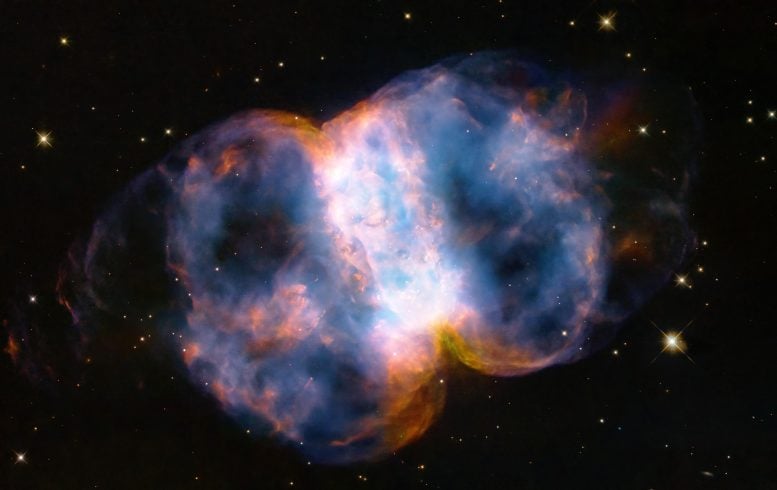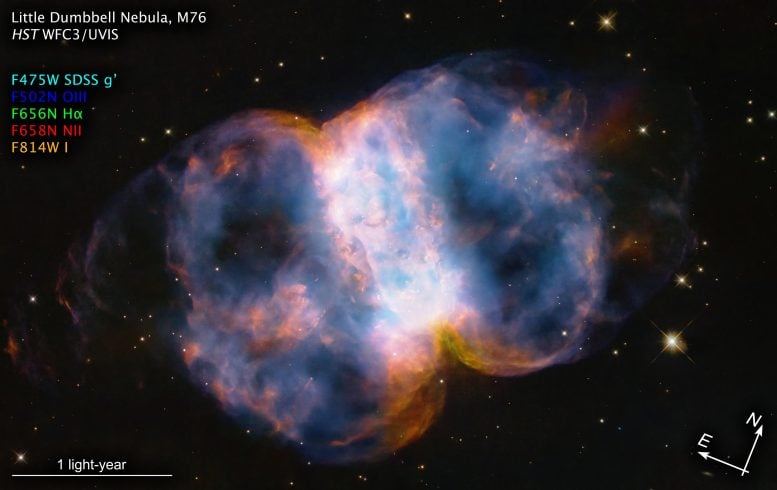
Astronomers marked the 34th anniversary of the Hubble Space Telescope by capturing a picture of the Little Dumbbell Nebula, which is 3400 light-years away. Hubble has conducted 1.6 million observations and contributed to over 44,000 scientific papers, expanding our understanding of the universe. The James Webb Space Telescope complements its findings. Credit: NASA, ESA, STScI, A. Pagan (STScI)
Shining Bipolar Bubble From Dying Star Expands Into Space
To celebrate the 34th anniversary of the launch of NASA’s legendary Hubble Space Telescope on April 24, 1990, astronomers took a picture of the Little Dumbbell Nebula, also known as Messier 76, M76, or NGC 650/651. It consists of a ring, seen edge-on as the central bar structure, and two lobes on either end of the ring.
Before a red giant star burnt out, it emitted a ring of gas and dust, likely shaped by the effects of a binary companion star. This ejected material formed a thick disk of dust and gas along the plane of the companion’s orbit. The hypothetical companion star isn’t visible in the Hubble image, so it may have been consumed by the central star. The disk could be evidence of that stellar cannibalism.
The visually appealing nebula is a popular subject for amateur astronomers. Professional astronomers initially analyzed it in 1891, determining it was a nebula rather than a galaxy or a star cluster. They proposed that M76 might be similar to the donut-shaped Ring Nebula (M57), viewed from the side.
For more than three decades, the NASA/ESA Hubble Space Telescope has transformed modern astronomy, engaging the public in an extraordinary journey of exploration and discovery. Each year, Hubble dedicates a portion of its observing time to capturing a special anniversary image of particularly beautiful and significant objects. Hubble’s 34th launch anniversary is commemorated with a picture of the Little Dumbbell Nebula. Credit: NASA, ESA, STScI, A. Pagan (STScI), N. Bartmann (ESA/Hubble)
Hubble Marks 34th Anniversary With a Glimpse of the Little Dumbbell Nebula
To celebrate the 34th anniversary of the launch of the renowned NASA/ESA Hubble Space Telescope on 24 April, astronomers captured an image of the Little Dumbbell Nebula (also known as Messier 76, M76, or NGC 650/651) situated 3400 light-years away in the northern circumpolar constellation Perseus. The visually striking nebula is a popular target for amateur astronomers.
M76 is classified as a planetary nebula, an expanding shell of glowing gases expelled from a dying red giant star. The star eventually collapses into an ultra-dense and hot white dwarf. A planetary nebula is not related to planets, but earned its name because astronomers in the 1700s, using low-power telescopes, thought this type of object resembled a planet.
M76 is made up of a ring, observed edge-on as the central bar structure, and two lobes on either end of the ring. Before the star burnt out, it released a ring of gas and dust, potentially influenced by the presence of a binary companion star. This ejected material formed a thick disk of dust and gas along the plane of the companion’s orbit. The hypothetical companion star is not visible in the Hubble image, so it may have been consumed by the central star. The disk could serve as evidence for this stellar cannibalism.

For its 34th anniversary, the Hubble Telescope took a picture of the Little Dumbbell Nebula, showing its ongoing role in cosmic discoveries and astronomical research. Credit: NASA, ESA, STScI, A. Pagan (STScI)
The main star is collapsing to become a white dwarf. It is one of the hottest remaining stars known, at a very hot 120,000 degrees Celsius, 24 times the temperature of our Sun’s surface. The white dwarf can be seen as a tiny point in the middle of the nebula. A star visible below it is not part of the nebula.
Squeezed by the disc, two lobes of hot gas are escaping from the upper and lower parts of the ‘belt’ along the star’s axis of rotation that is at right angles to the disc. They are being pushed by the storm-like outflow of material from the dying star, traveling through space at two million miles per hour. That’s fast enough to go from Earth to the Moon in just over seven minutes! This powerful ‘stellar wind’ is crashing into cooler, slower-moving gas that was ejected at an earlier stage in the star’s life when it was a red giant. Intense ultraviolet radiation from the extremely hot star is making the gases glow. The red color comes from nitrogen, and the blue comes from oxygen.
Considering that our solar system is 4.6 billion years old, the entire nebula exists for a very short time in cosmological terms. It will disappear in about 15,000 years.
Hubble’s Revolutionary Scientific Achievements
Since it was sent into space in 1990, Hubble has made 1.6 million observations of over 53,000 astronomical objects. So far, the Mikulski Archive for Space Telescopes at the Space Telescope Science Institute in Baltimore, Maryland stores 184 terabytes of processed data that are ready for use by astronomers around the world for research and analysis. A European copy of the public data is kept at ESA’s European Space Astronomy Centre (ESAC), in the European Hubble Space Telescope (eHST) Science Archive.
Since 1990, 44,000 scientific papers based on Hubble’s observations have been published. This includes a record 1056 papers published in 2023, of which 409 were led by authors in the ESA Member States. The demand for using Hubble is so high that it is currently oversubscribed by a factor of six.
Throughout the past year of scientific operations, new discoveries made using Hubble include discovering water in the atmosphere of the smallest exoplanet found to date, sighting a strange cosmic explosion far from any host galaxy, tracking markings on the rings of Saturn, and finding the surprising origin of the most distant and powerful fast radio burst observed so far. Hubble’s studies of the asteroid Dimorphos, the target of a deliberate NASA spacecraft collision in September 2022 to change its path, continued with the discovery of rocks released by the impact.
This video shows the 34th-anniversary image of the launch of the renowned NASA/ESA Hubble Space Telescope: the Little Dumbbell Nebula (also known as Messier 76, M76, or NGC 650/651). The object is situated 3400 light-years away in the northern circumpolar constellation Perseus. The attractive nebula is a popular target for amateur astronomers. Credit: NASA, ESA, STScI, A. Pagan (STScI), Acknowledgment: D. Crowson, A. Fujii, Digitized Sky Survey
Hubble has also continued to provide amazing pictures of things in space like spiral galaxies, globular clusters, and star-forming nebulae. A newly forming star was the source of a cosmic light show. Hubble's pictures were also combined with heat-based observations from the NASA/ESA/CSA James Webb Space Telescope to make one of the most complete views of the Universe ever, a picture of galaxy cluster MACS 0416.
Most of Hubble’s discoveries were not expected before the telescope was sent to space, like supermassive black holes, the atmospheres of planets outside our solar system, the bending of light by dark matter, the existence of dark energy, and the large number of planet formation around stars. Hubble will continue to study those areas, as well as using its special ability to look at ultraviolet light to study things like Solar System events, exploding stars, the air around planets outside our solar system, and active radiation from galaxies. And Hubble is still learning from its long history of watching things in our Solar System, stars that change in brightness, and other unusual things in space.
The abilities of the James Webb Space Telescope were made to work well with Hubble, not to replace it. In the future, Hubble will also use the chance to work together with Webb, which looks at the Universe using heat. Together, the two space telescopes can study things like young star systems, the stuff that planets outside our solar system are made of, rare exploding stars, the centers of galaxies, and the chemicals in faraway parts of the Universe.
The Hubble Space Telescope has been working for more than three decades and keeps making important discoveries that shape our basic understanding of the Universe.
Hubble is a project of international work between NASA and ESA (European Space Agency). NASA’s Goddard Space Flight Center in Greenbelt, Maryland, is in charge of the telescope and its work. Lockheed Martin Space, based in Denver, Colorado, also helps with the telescope's work at Goddard. The Space Telescope Science Institute in Baltimore, Maryland, which is run by the Association of Universities for Research in Astronomy, runs Hubble's scientific work for NASA.



